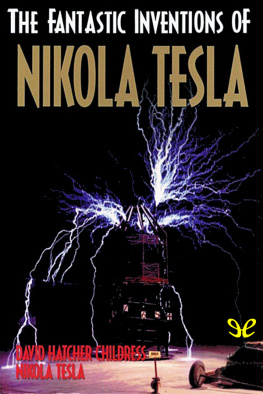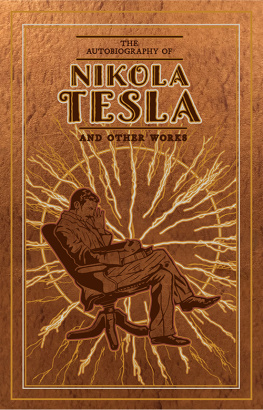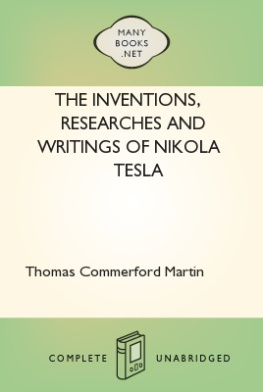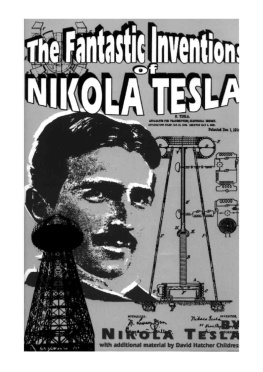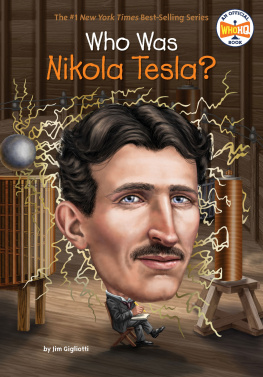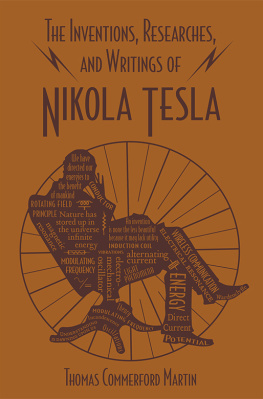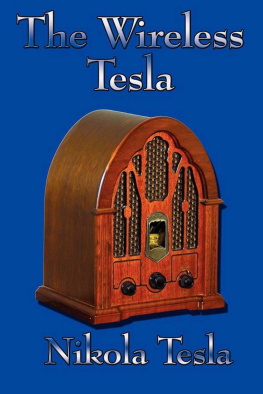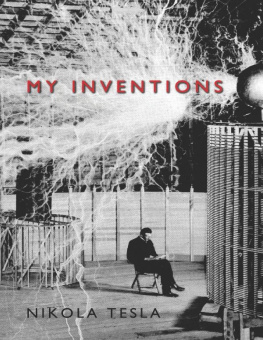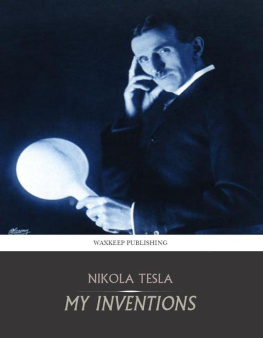David H. Childress - The fantastic inventions of Nikola Tesla
Here you can read online David H. Childress - The fantastic inventions of Nikola Tesla full text of the book (entire story) in english for free. Download pdf and epub, get meaning, cover and reviews about this ebook. year: 1993, publisher: ePubLibre, genre: Religion. Description of the work, (preface) as well as reviews are available. Best literature library LitArk.com created for fans of good reading and offers a wide selection of genres:
Romance novel
Science fiction
Adventure
Detective
Science
History
Home and family
Prose
Art
Politics
Computer
Non-fiction
Religion
Business
Children
Humor
Choose a favorite category and find really read worthwhile books. Enjoy immersion in the world of imagination, feel the emotions of the characters or learn something new for yourself, make an fascinating discovery.
- Book:The fantastic inventions of Nikola Tesla
- Author:
- Publisher:ePubLibre
- Genre:
- Year:1993
- Rating:5 / 5
- Favourites:Add to favourites
- Your mark:
- 100
- 1
- 2
- 3
- 4
- 5
The fantastic inventions of Nikola Tesla: summary, description and annotation
We offer to read an annotation, description, summary or preface (depends on what the author of the book "The fantastic inventions of Nikola Tesla" wrote himself). If you haven't found the necessary information about the book — write in the comments, we will try to find it.
The fantastic inventions of Nikola Tesla — read online for free the complete book (whole text) full work
Below is the text of the book, divided by pages. System saving the place of the last page read, allows you to conveniently read the book "The fantastic inventions of Nikola Tesla" online for free, without having to search again every time where you left off. Put a bookmark, and you can go to the page where you finished reading at any time.
Font size:
Interval:
Bookmark:
Tesla maintained a residence at the old Waldorf-Astoria Hotel in New York City from the spring of 1899 to 1915. He maintained by mortgaging the Wardenclyffe property and tower to the hotel and its owner, George C. Boldt. Since the anticipated income from the Wardenclyffe project of transmitting messages across the Atlantic was unrealized, Tesla was unable to repay the mortgages. Action was taken by the mortgagees in 1915 to foreclose on the property, and a bill of sale offered to Lester S. Holmes, a developer. The property would be sold to Holmes and the tower would be destroyed so that property could be developed.
Tesla appealed the foreclosure judgment, and the case was heard by the Supreme Court of the State of New York, Suffolk County. Tesla lost the case on appeal. Following the judgment on April 20, 1922, Tesla vacated his suite at the Waldorf-Astoria and took up residence at the Hotel St Regis.
Though the 313 page transcript document largely contains the various lawyers arguing about the legal instruments of mortgaging and foreclosure actions, portions of the testimony are interesting. During Teslas testimony, he give important information about the Wardenclyffe installation (transcript pages 163-181). Next is a portion of Ezra C. Binghams testimony, chief engineer for the Waldorf-Astoria, in which he describes how the tower had been vandalized, and how poor the condition of the plant was (transcript pages 235-247). Tesla returns to the stand and gives more information on the purpose of the plant (transcript pages 269-275), and finally is Exhibit B, Teslas inventory of the plant(transcript pages 309-312).
Nikola Tesla for the Defendant p. 303 transcript pages 163-181.
Ezra C. Bingham for Plaintiff p. 323 transcript pages 235-247.
Nikola Tesla for the Defendant p. 337 transcript pages 269-275.
Defendants Exhibit B p. 344 transcript pages 309-312 (inventory of plant)
Nikola Tesla for DefendantDirect.
A. Of course I had signed and the transaction was completed.
Q. And those papers were then in Mr. Hutchins possession?
A. Yes those were almost his parting words.
Q. I think you said that conversation took place early in 1917 or late in 1916?
A. I think early in 1917, if I remember rightly, but my memory is a little on account of the concentration
Mr. Hawkins: I do not recall the date of that deed.
Mr. Fordham: Why dont you let your witness complete his answer about his memory?
Mr. Hawkins: I assumed he had.
By Mr. Fordham:
Q. What were you saying?
A. I answered all the questions to the best of my ability.
Q. No, counsel interrupted you intentionally in the middle of a sentence
Mr. Hawkins: That is not true, that I interrupted him intentionally.
Mr. Fordham: Well, strike out the word intentionally. You interrupted him in the middle of the sentence. He can say what he started to say about his memory in connection with this transaction. The witness evidently thinks he does not need to pay any attention to what I say. Will your Honor kindly instruct the witness to complete his answer.
By the Referee:
Q. Had you completed your answer?
A. Yes, those were the parting words of Mr. Hutchins.
By Mr. Hawkins:
Q. As Mr. Fordham seems anxious to have you complete what you said, I heard what you said Mr. Fordham: He says he has completed.
A. Yes/in regard to the memory of the exact date, 1 say that I cannot exactly remember the dates on account of concentration on some other work that I am doing now, but I can easily ascertain all the dates from documents.
Q. Now at the time that you delivered that document to Mr. Hutchins, I refer now to the deed, will you please describe to the Court what there was upon the property?
A. Upon the property?
Q. Yes, described in the deed, which property is situated at Rocky Point
Mr. Fordham: That is objected to on the ground it is incompetent, immaterial and irrelevant at this point what there was on the property.
The Referee: I will take it,
Mr. Fordham: We except
The Referee: You mean structures, I suppose?
Mr. Hawkins: Yes, absolutely. Improvements, I had in mind, if there were any buildings there or structures.
Q. Tell the Court what there was there.
A. There was a brick building in which was located the power plant
Q. Please describe the size of the brick building.
A. The building forms a square about one hundred by one hundred feet wide and it is one floor, rather high, with a roof covered with gravel, as they usually make them. This building was divided inside in four compartments, two of which were very large, one being the machine shop
Q. How large was that?
A. That was one hundred feet by about thirty-five feet, I should say.
Q. Now tell how big the other compartments were.
A. The other one was about one hundred by thirty-five and then these other two smaller ones where the engines were located on one side and the boilers on the other were about thirty by forty, thirty one way and forty the other.
Q. I think you said the building was one story high?
A. Yes.
Q. It had one floor, did it?
A. One floor, yes.
Q. Further describe the building, if there is any further description, and tell the Court whether there were any brick chimneys, outside chimneys?
A. Oh yes, right in the center of the building rose the chimney.
Q. How big was the chimney?
A. The chimney was four by four feet; it was calculated to give the proper speed to the products of combustion under the boilers.
Q. Of what was the chimney composed?
A. Brick.
Q. How high was the building?
A. The building might have been, I think the extent of the walls on one side, the lowest part of the roof might have been something like twenty-eight feet, I would say.
Q. Twenty-eight feet at the corners of the building?
A. Yes.
Q. And did it have a gable roof or a lantern roof?
A. Yes, as you call it in English how is this roof called?
Q. I think it is a gable roof.
A. Gable roof. The building was resting on cement foundations and there were the usual modern conveniences and
Q. Tell what you mean by the usual modern conveniences?
A. I mean the channels for leading off the waste, the rain drips and all that, and then attached to it was, of course, the water pump that pumped the water for the building.
Mr. Fordham: I do not wish to interrupt counsel but what possible use can there be in a detailed description of the building on this property?
The Referee: I do not know at this time.
Mr. Fordham: Neither do I. It does not seem to me that we should burden the record indefinitely with these descriptive details.
The Referee: I will let him describe them.
Mr. Hawkins: It is a material part of the defense here.
The Referee: Go ahead. I will take it.
The Witness: I suppose what belongs to the buildings is the boiler plant, with two 300 horse power boilers on one side
Q. That was two 300-horse power?
A. Two 300-horse power boilers, yes, and the pumps, injectors and other accessories, and then there were big water tanks that wore placed around the chimney so as to utilize some of the waste heat. These tanks had a capacity of about 16,000 gallons, if I am correct.
Q. Of what were the tanks composed?
A. Of quarter inch thick sheet steel, galvanized.
Q. Those were all in one compartment, were they?
A. They were around the chimney under the roof, and for this purpose the room had an extension upward there. This could be shown on a photograph if his Honor wishes to see the photograph.
Q. Just a moment please. Now describe the other three compartments of the building.
A. Well, I have described the boiler plant Now right opposite to the boiler plant lengthwise was a corresponding compartment and therein were located the engines. Of these engines there was one 400-horse power Westinghouse reciprocating engine, driving a directly connected dynamo which was specially made for my purposes. Then there was a 35-kilowatt Westinghouse outfit also driving the dynamo, which was for the purpose of lighting and other work, a permanent attachment to the building to furnish all conveniences. There was then a high pressure compressor which also formed an essential part of the equipment. And then there was a low pressure compressor or blower. Then there was a high pressure pump and a reciprocating low pressure pump. That was all
Next pageFont size:
Interval:
Bookmark:
Similar books «The fantastic inventions of Nikola Tesla»
Look at similar books to The fantastic inventions of Nikola Tesla. We have selected literature similar in name and meaning in the hope of providing readers with more options to find new, interesting, not yet read works.
Discussion, reviews of the book The fantastic inventions of Nikola Tesla and just readers' own opinions. Leave your comments, write what you think about the work, its meaning or the main characters. Specify what exactly you liked and what you didn't like, and why you think so.

